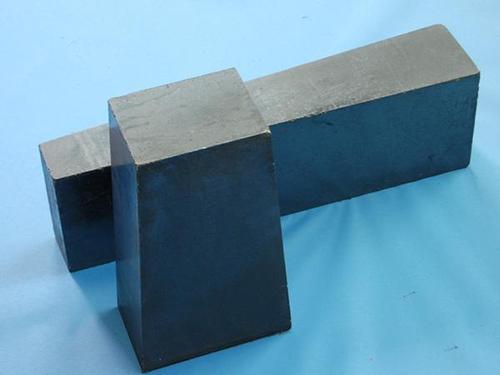- 27
- Jan
Процесът на производство на магнезиеви въглеродни огнеупорни тухли
Производственият процес на магнезиеви въглеродни огнеупорни тухли
суров материал
The main raw materials of MgO-C bricks include fused magnesia or sintered magnesia, flake graphite, organic binders and antioxidants.
магнезия
Магнезият е основната суровина за производството на тухли MgO-C, които могат да бъдат разделени на разтопен магнезиев оксид и синтерован магнезиев оксид. В сравнение със синтерованата магнезия, стопената магнезия има предимствата на едри кристални зърна на периклаза и голяма обемна плътност на частиците. Това е основната суровина, използвана при производството на магнезиеви въглеродни тухли. Производството на обикновени магнезиеви огнеупорни материали изисква високотемпературна якост и устойчивост на корозия за магнезиевите суровини. Поради това се обръща внимание на чистотата на магнезия и съотношението C/S и съдържанието на B2O3 в химичния състав. С развитието на металургичната индустрия условията за топене стават все по-взискателни. В допълнение към химичния състав, магнезият, използван в тухлите MgO-C, използвани в металургичното оборудване (конвертор, електрическа пещ, черпак и др.), изисква висока плътност и голяма кристализация.
Източник на въглерод
Whether in traditional MgO-C bricks or low-carbon MgO-C bricks that are used in large quantities, flake graphite is mainly used as its carbon source. Graphite, as the main raw material for the production of MgO-C bricks, mainly benefits from its excellent physical properties: ① non-wetting to slag. ②High thermal conductivity. ③Low thermal expansion. In addition, graphite and refractory materials do not eutectic at high temperatures, and have high refractoriness. The purity of graphite has a greater impact on the performance of MgO-C bricks. Generally, graphite with a carbon content of more than 95%, and very good, more than 98% should be used.
In addition to graphite, carbon black is also commonly used in the production of magnesia carbon bricks. Carbon black is a highly dispersed black powdery carbonaceous material produced by the thermal decomposition or incomplete combustion of hydrocarbon hydrocarbons. The carbon black has fine particles (less than 1μm), large specific surface area, and the mass fraction of carbon is 90~ 99%, high purity, high powder resistivity, high thermal stability, low thermal conductivity, it is difficult to graphitize carbon. The addition of carbon black can improve the spalling resistance of MgO-C bricks, increase the amount of residual carbon, and increase the density of the bricks.
Binding agent
Често използвани свързващи вещества за производството на тухли MgO-C включват каменовъглен катран, каменовъглен катран и петролна смола, както и специални въглеродни смоли, полиоли, модифицирани в смола фенолни смоли, синтетични смоли и др. Използваният свързващ агент има следните видове:
1) Asphalt substances. Tar pitch is a kind of thermoplastic material. It has the characteristics of high affinity with graphite and magnesium oxide, high residual carbon rate after carbonization, and low cost. It has been used in large quantities in the past; but tar pitch contains carcinogenic aromatic hydrocarbons, especially the content of benzophthalone. High; due to the strengthening of environmental awareness, the use of tar pitch is now decreasing.

2) Resin substances. Synthetic resin is made by the reaction of phenol and formaldehyde. It can mix well with refractory particles at room temperature. After carbonization, the residual carbon rate is high. It is currently the main binder for the production of MgO-C bricks; but it is formed after carbonization. The glassy network structure is not ideal for the thermal shock resistance and oxidation resistance of refractory materials.
3) На базата на асфалт и смола, веществото, получено след модификация. Ако свързващият агент може да бъде карбонизиран, за да образува инкрустирана структура и да образува материал от въглеродни влакна in situ, тогава този свързващ агент ще подобри високотемпературните характеристики на огнеупорния материал.
Антиоксидантите
In order to improve the oxidation resistance of MgO-C bricks, a small amount of additives are often added. Common additives are Si, Al, Mg, Al-Si, Al-Mg, Al-Mg-Ca, Si-Mg-Ca, SiC, B4C , BN and very recently reported Al-BC and Al-SiC-C additives [5-7]. The principle of action of additives can be roughly divided into two aspects: On the one hand, from the perspective of thermodynamics, that is, at working temperature, additives or additives react with carbon to form other substances, and their affinity for oxygen is greater than that of carbon and oxygen. , It takes precedence over carbon to be oxidized to protect carbon; on the other hand, from the perspective of kinetics, the chemical Density, block pores, hinder the diffusion of oxygen and reaction products, etc.
